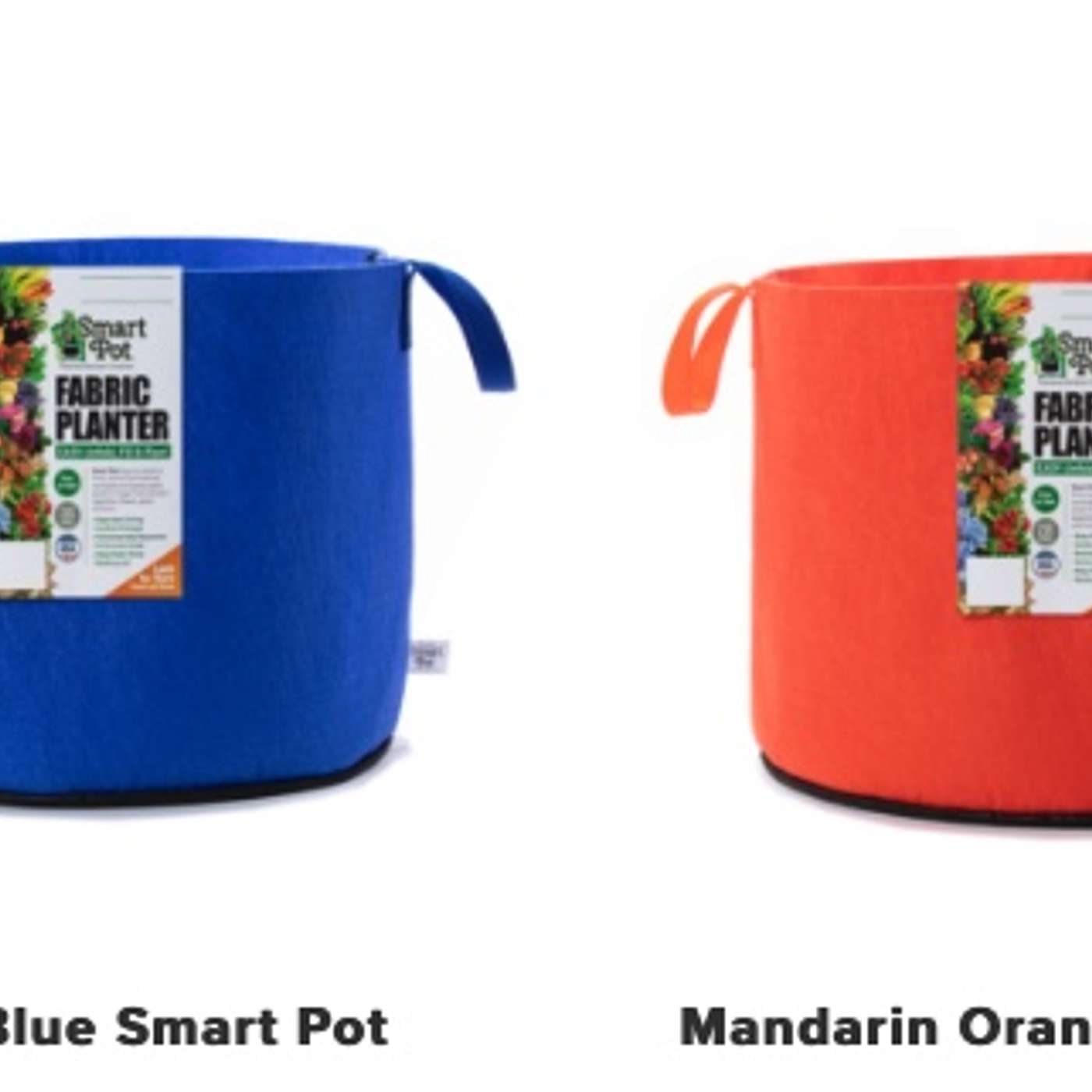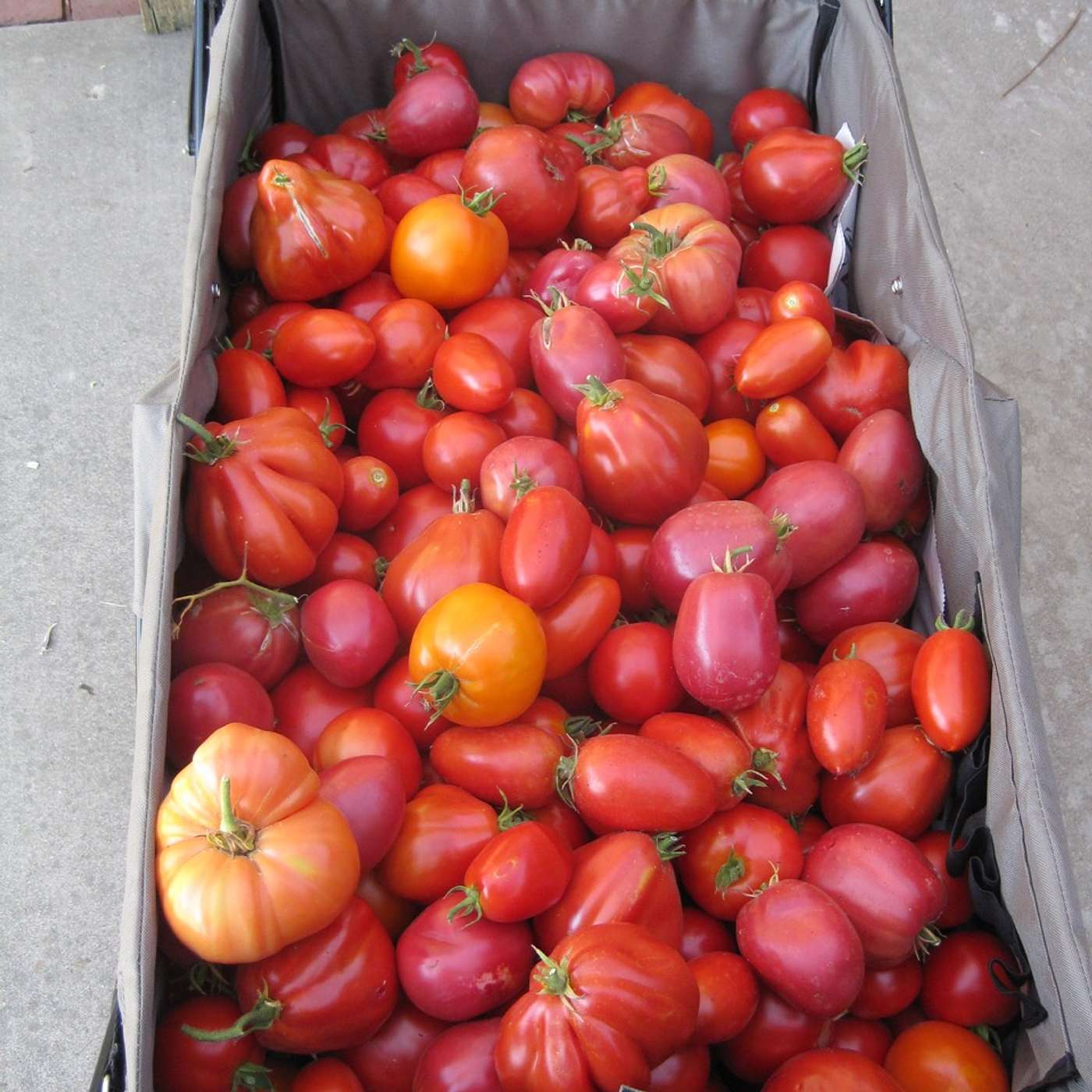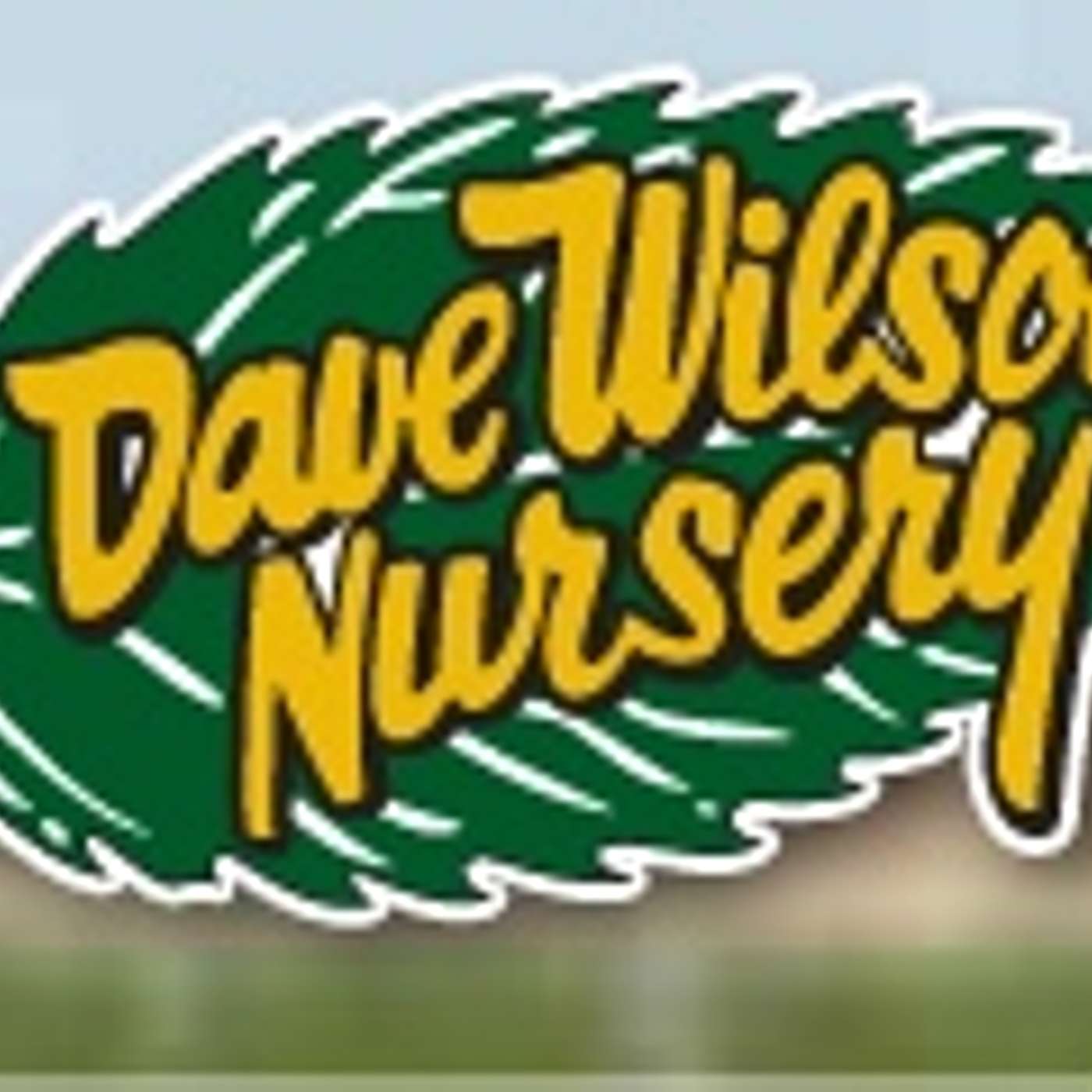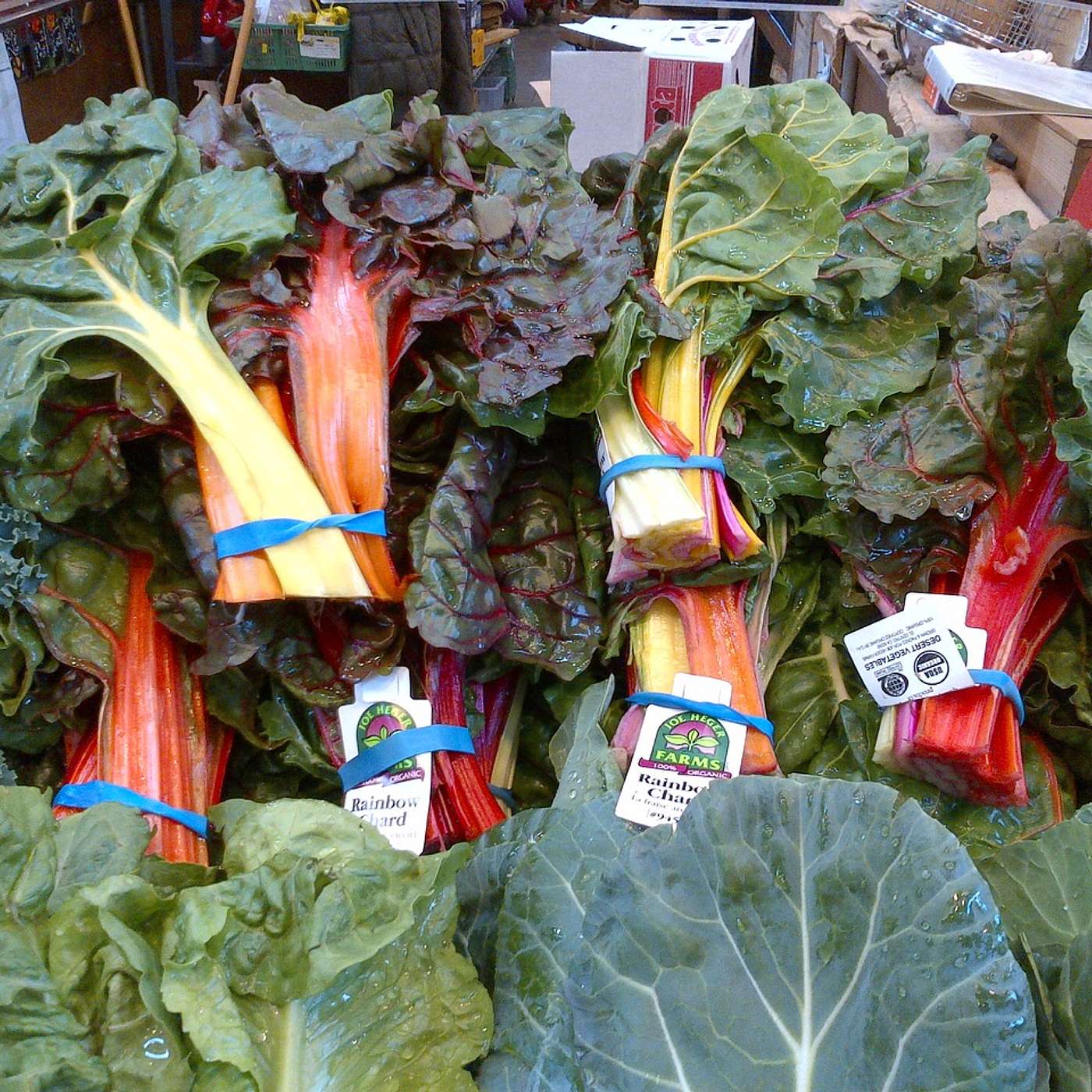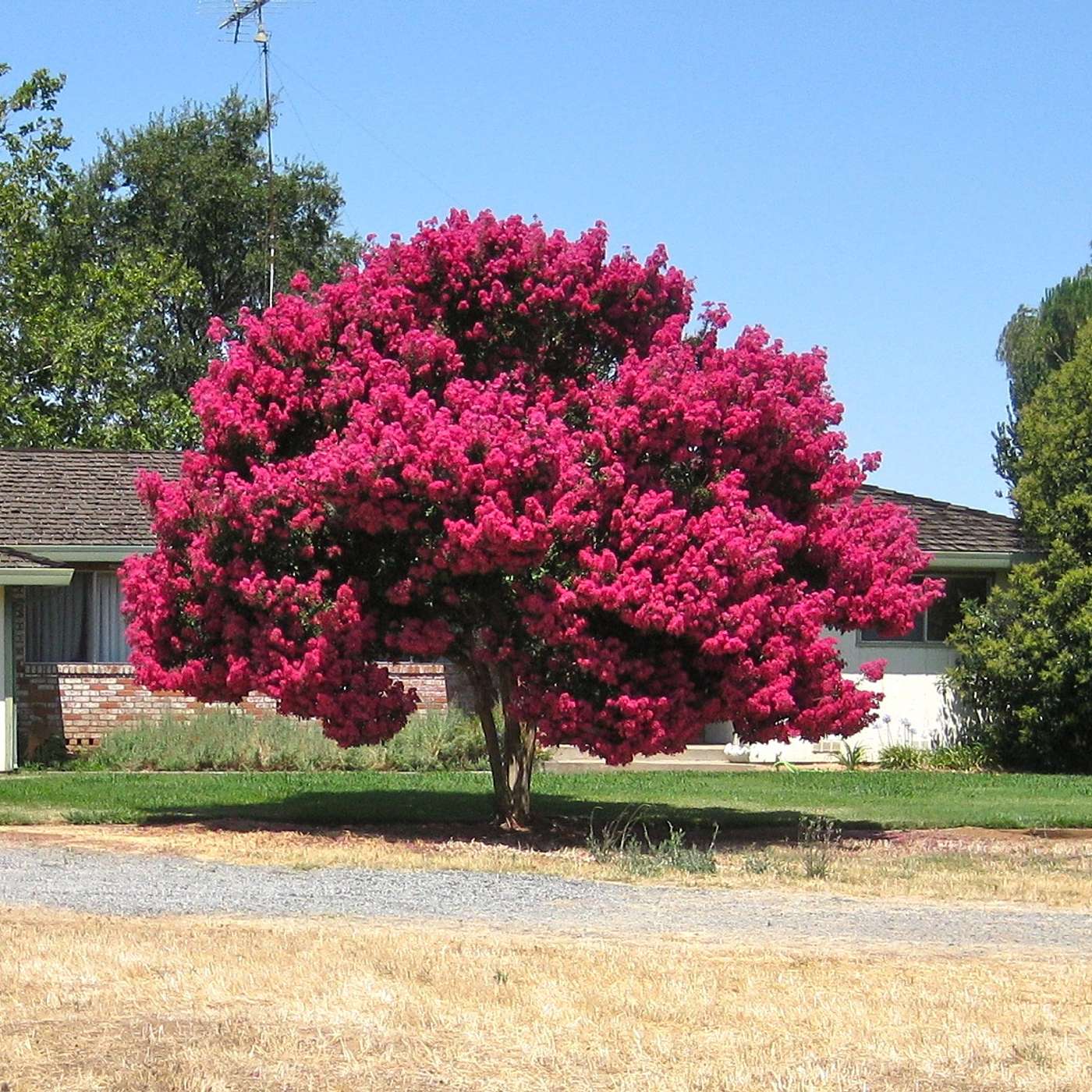Garden Basics with Farmer Fred
125 Lavender. Crape Myrtle Tree. Harvesting and Storing Fruits and Vegetables
Growing lavender? Our favorite retired college horticulture professor, Debbie Flower, has tips on how to rejuvenate aging lavender plants. UC Davis Arboretum Superintendent Emeritus Warren Roberts tells us all about that prolific summer bloomer, the crape myrtle tree. How can you tell when is best for harvesting backyard fruits and vegetables? And, when you bring them inside, where’s the best place to store them to last the longest? On the counter, in the refrigerator, or some combination of both? We supply the answers to those questions for some of the most popular backyard crops.
It’s all on episode 125 of the Garden Basics with Farmer Fred podcast, brought to you today by Smart Pots and Dave Wilson Nursery.
And we will do it all in under 30 minutes. Let’s go!
Pictured:
Crape Myrtle Tree
Links:
Smart Pots
Dave Wilson Nursery
UC Davis Arboretum
UC Davis Postharvest Care of Fruits and Vegetables
Book: Pruning and Training
Video: Farmer Fred on Cool Season Vegetable Gardening
Harvest Day Zoom link registration for Farmer Fred Q&A, Sat. Aug. 7
More episodes and info available at Garden Basics with Farmer Fred
Garden Basics comes out every Tuesday and Friday. More info including live links, product information, transcripts, and chapters available at the home site for Garden Basics with Farmer Fred. Please subscribe, and, if you are listening on Apple, please leave a comment or rating. That helps us decide which garden topics you would like to see addressed.
Got a garden question? There are several ways to get in touch:
leave an audio question without making a phone call via Speakpipe, at https://www.speakpipe.com/gardenbasics
Call or text us the question: 916-292-8964.
E-mail: fred@farmerfred.com
or, leave a question at the Facebook, Twitter or Instagram locations below.
Be sure to tell us where you are when you leave a question, because all gardening is local.
And thank you for listening.
All About Farmer Fred:
Farmer Fred website: http://farmerfred.com
Daily Garden tips and snark on Twitter
The Farmer Fred Rant! Blog
Facebook: "Get Growing with Farmer Fred"
Instagram: farmerfredhoffman
Farmer Fred Garden Videos on YouTube
As an Amazon Associate, I earn from qualifying purchases from possible links mentioned here.
Thank you for listening, subscribing and commenting on the Garden Basics with Farmer Fred podcast and the Beyond the Garden Basics Newsletter.
Growing lavender? Our favorite retired college horticulture professor, Debbie Flower, has tips on how to rejuvenate aging lavender plants. UC Davis Arboretum Superintendent Emeritus Warren Roberts tells us all about that prolific summer bloomer, the crape myrtle tree. How can you tell when is best for harvesting backyard fruits and vegetables? And, when you bring them inside, where’s the best place to store them to last the longest? On the counter, in the refrigerator, or some combination of both? We supply the answers to those questions for some of the most popular backyard crops.
It’s all on episode 125 of the Garden Basics with Farmer Fred podcast, brought to you today by Smart Pots and Dave Wilson Nursery.
And we will do it all in under 30 minutes. Let’s go!
Pictured:
Crape Myrtle Tree
Links:
Smart Pots
Dave Wilson Nursery
UC Davis Arboretum
UC Davis Postharvest Care of Fruits and Vegetables
Book: Pruning and Training
Video: Farmer Fred on Cool Season Vegetable Gardening
Harvest Day Zoom link registration for Farmer Fred Q&A, Sat. Aug. 7
More episodes and info available at Garden Basics with Farmer Fred
Garden Basics comes out every Tuesday and Friday. More info including live links, product information, transcripts, and chapters available at the home site for Garden Basics with Farmer Fred. Please subscribe, and, if you are listening on Apple, please leave a comment or rating. That helps us decide which garden topics you would like to see addressed.
Got a garden question? There are several ways to get in touch:
leave an audio question without making a phone call via Speakpipe, at https://www.speakpipe.com/gardenbasics
Call or text us the question: 916-292-8964.
E-mail: fred@farmerfred.com
or, leave a question at the Facebook, Twitter or Instagram locations below.
Be sure to tell us where you are when you leave a question, because all gardening is local.
And thank you for listening.
All About Farmer Fred:
Farmer Fred website: http://farmerfred.com
Daily Garden tips and snark on Twitter
The Farmer Fred Rant! Blog
Facebook: "Get Growing with Farmer Fred"
Instagram: farmerfredhoffman
Farmer Fred Garden Videos on YouTube
As an Amazon Associate, I earn from qualifying purchases from possible links mentioned here.
Thank you for listening, subscribing and commenting on the Garden Basics with Farmer Fred podcast and the Beyond the Garden Basics Newsletter.
GB 125 Lavender. Crape Myrtle. Storing Vegs
24:04
SPEAKERS
Terri in Nevada City, Warren Roberts, Debbie Flower, Farmer Fred
Farmer Fred 00:00
Garden Basics with Farmer Fred is brought to you by Smart Pots, the original lightweight, long lasting fabric plant container. it's made in the USA. Visit SmartPots.com slash Fred for more information and a special discount, that's SmartPots.com/Fred.
Farmer Fred 00:20
Welcome to the Garden Basics with Farmer Fred podcast. If you're just a beginning gardener or you want good gardening information well you've come to the right spot.
Farmer Fred 00:32
Are you growing lavender? Our favorite retired college horticulture Professor, Debbie Flower, has tips on how to rejuvenate aging lavender plants. UC Davis Arboretum Superintendent Emeritus Warren Roberts tells us all about that prolific summer bloomer, the crape myrtle tree. How can you tell when it's best for harvesting backyard fruits and vegetables? And when you bring them inside, where's the best place to store them to last the longest? Put them on the counter or in the refrigerator? Or maybe some combination of both? We supply the answers to those questions for some of our most popular backyard crops. It's all on episode 125 of the Garden Basics with Farmer Fred podcast, brought to you today by Smart Pots and Dave Wilson nursery. And we'll do it all in under 30 minutes. Let's go.
Terri in Nevada City 01:25
It's Terri, up here in Nevada City, zone seven. Can you talk lavender? I've got some seven or eight year old lavender plants there that are the Provance variety and getting a lot of die back, part of the plant is dying back. So I was wondering if it has anything to do with the rock mulch that I put under there. And also they get full of leaves, oak leaves. So in the springtime, I'm clearing out all the oak leaves that are packed into the plant. Can you talk about lavender for me, please? Thank you.
Farmer Fred 02:03
Terri, thanks so much for your question. Thanks for using Speakpipe.com slash gardenbasics and getting us that question. It's easy to use, everybody ought to try it. No data charges. It's free. Go ahead and give it a try. Speakpipe.com slash gardenbasics. Debbie Flower is here to help us answer garden questions here on the Garden Basics podcast. Terri is in Nevada city in the Sierra foothills, which is about 2000-3000 feet, I'm guessing, I don't know (Nevada City = 2,477 ft altitude). And she said USDA zone seven and that gets cold, that's down to zero or five degrees.
Debbie Flower 02:39
Yes, I taught up there for a while and I would drive from the Sacramento area, it took me at least an hour to get up to the Nevada City Campus of Sierra College and sometimes there would be snow there.
Farmer Fred 02:51
So, something to consider. How does lavender do in the snow?
Debbie Flower 02:55
Well, Terri has grown it for eight years. So it does okay. It has the ability to take cold She talked about using rock mulch and that's fine. Rock mulch covers the soil, it's a fine thing to use. The thing that piqued my interest is, she talked about the oak leaves falling in the plant. And so that would be happening in the fall. And when we get rain, Nevada City included, it is in that fall and winter and into the early spring. And if those leaves remain on the plant or around the stem of the plant, they can hold moisture there and that will cause death of lavender.
Farmer Fred 03:33
Oh, okay. So it has a very sensitive crown area.
Debbie Flower 03:36
Yes, it needs excellent drainage and does not want organic matter collecting up around the trunk of the plant. It can lead to diseases getting into the planting and killing them.
Farmer Fred 03:47
So Terry mentioned that she's using a rock mulch. What are the downsides of using a rock mulch around lavender?
Debbie Flower 03:54
For me, the rock mulch is a problem because it limits where I can plant things. Yeah. Eventually it collects organic matter over time. She talked about oak leaves falling in a garden, I can relate to that as well. And so those sections will get filled up but they'll just break down like organic matter does. Rock mulch can heat up, but it takes a while for that heat to transfer into the soil below. Depending on its color, it can reflect heat up into the plant and for some plants that's not desirable. And if it's big rock it can be actually very heavy. Yeah. And that can can physically impair the root development.
Farmer Fred 04:32
Does it compact the soil?
Debbie Flower 04:34
Well, not just sitting there, necessarily. But if it's big rock and it was brought by a truck or even a shovel and dumped there, that activity would compact soil, yes.
Farmer Fred 04:45
Now Terri did not mention the reason for using the rock. I'm wondering if it's because she wants to use a blower to blow the leaves away.
Debbie Flower 04:53
Yes, people do enjoy that. And there are some examples. It's mostly Alpine plants that live in rock that where you go see them and it may be it appeals to her visually. The plant being eight years old can look to have portions that look dead. Lavender is a woody plant, and as it ages, if it is not pruned regularly, annually, then the older stems will become more woody, and the plant will grow up and flop over so that it could look dead yet not be dead. In the winter, when it gets cold, it can take lavender in general can take down to USDA zone five, but it can look dead, it might lose some of its leaves and flower parts and such. And so the stems can look dead. So it's good to know how to check if a stem is truly dead. And that is to take your thumbnail or something equivalent and scrape along the bark. Don't do it in a lot of places, but do it where you think it might be dead. And I usually start at the tip of a branch I think might be dead, because sometimes that can allow disease in and then that portion you scraped can become a problem. So I started at the tip in case I need to cut that off and you want to scrape it should come off the bark should come off easily. And it should be shiny and probably green underneath the shiny and this would be moisture from life and the green would be the chlorophyll. If that part is dead, you can work your way back toward the crown which is the center of the plant and keep checking and if the whole branch is dead, it should be removed when death is found. Pruning of dead, diseased and damaged plant parts should be done when they are seen, not at any particular season.
Farmer Fred 04:55
One of my favorite books is the American Horticultural Society's "Pruning and Training" book. It mentions about lavender, to replace old and neglected specimens. Would this be in that category?
Debbie Flower 06:41
It could be. She doesn't talk about whether she's been pruning it or not. I have a single lavender plant in my landscape. It's probably also about eight years old and some years I prune it and some years I don't. And when I prune it, it's gorgeous and it's symmetrical and every year it blooms beautifully whether I do that, pruning or not. But if you do prune, you want to wait until after it's flowered, then the plant will generally throw new growth. And if you have one of those bare stems laying out because the plant has grown up and fallen over, you might see new growth down close to the crown of the plant on that and you can prune back. As long as you leave several inches of active green growth on the plants. You want active little stems with green on them. The reference I looked at said leave two inches on them. to me that's not quite enough, I would leave probably four and then you have are pretty much guaranteed of regrowth and a more compact plant.
Farmer Fred 07:36
And I guess if you prune back into the old wood, it's probably not going to resprout.
Debbie Flower 07:40
Right. If you prune back into wood that does not have that growth on it, it will not re sprout you can kill it that way. If you prune at the wrong time, prune it in winter when it's kind of naked, it won't recover.
Farmer Fred 07:51
So autumn?
Debbie Flower 07:53
Well, after flowering. I have flowering is in spring. So yeah, after flowering is the best time .
Farmer Fred 07:58
Yeah. And that gives you plenty of time to set out new growth.
Debbie Flower 08:00
Right.
Farmer Fred 08:01
Okay, that should help.
Debbie Flower 08:03
I hope so.
Farmer Fred 08:04
Right, Terri, hope that helps you out with your lavender. Thanks for the question. And thank you, Debbie Flower for your lavender-like knowledge.
Debbie Flower 08:10
You're welcome, Fred.
Farmer Fred 08:16
We're glad to have Smart Pots on board supporting the Garden Basics podcast. Smart Pots are the original, award-winning fabric planter. They're sold worldwide. Smart Pots are proudly made 100% in the USA. I'm pretty picky about who I allow to advertise on this program. My criteria, though, is pretty simple. It has to be a product I like; a product I use; a product I would buy again. And Smart Pots clicks all those boxes. They're durable. They're reusable. Smart Pots are available at independent garden centers and select Ace and True Value stores nationwide. To find a store near you visit SmartPots.com slash Fred. It's Smart Pots, the original award winning fabric planter. go to SmartPots dot com slash Fred for more info and that special Farmer Fred discount on your next Smart Pot purchase, go to SmartPots.com slash Fred.
Farmer Fred 09:15
Many gardeners are experts at planting and raising vegetables in the backyard garden. However, figuring out the best time to harvest those crops at optimum flavor and nutrition can be a guessing game. In addition, few gardeners know the best way to store those fresh veggies after they’ve been picked. Here are some tips from the Home Garden Seed Association (online at ezfromseed.org) and the UC Davis Department of Postharvest Technology: • Tomatoes. In most cases, tomatoes should be slightly soft when squeezed before picking, and fully colored. However, there are exceptions. Large heirloom tomatoes can be prone to cracking, and are best picked before they have completely turned color. They’ll continue to ripen after harvest. Store tomatoes on the kitchen counter, out of directly light and heat, in a vented plastic bowl or a perforated plastic bag. Tomatoes kept in the refrigerator will not ripen and will lose their flavor. • Green Beans. Pick them when they are long, slender and crisp, before the seeds form lumps in the pods. Pick them often, as beans can become tough and stringy on the vine. Store in the refrigerator in perforated plastic bags in the produce drawers. Use within a few days. Don’t mix fruits with vegetables in the same refrigerator drawer; the ethylene gas produced by the fruits is detrimental to the quality of nearby vegetables. • Summer Squash. Small is better. Zucchini and yellow crookneck squash are at their most tender when no bigger than four to six inches. Patty Pan squash is best picked when only three inches or smaller. Store in the refrigerator. • Peppers. Let them turn to their mature color on the plant, probably red, yellow or orange for maximum flavor. Check them daily, as peppers deteriorate very quickly after reaching maturity. There’s nothing wrong with picking and eating them when green, though. Clip, don’t pull, the peppers from the plant when they’re firm and full sized. Room temperature storage is best. However, peppers, cucumbers and eggplant can be kept in the refrigerator for one to three days if they are used soon after removal from the refrigerator. • Melons. Forget about thumping the melon to determine ripeness. Watermelons turn a dull color when ripe, and the tendril closest to the fruit is shriveling. For cantaloupes, the well-defined netting will turn green to tan. Honeydews develop a yellow blush on their ivory rinds. Store melons at room temperature. • Eggplants. Look for the nice, reflective sheen when they are at their peak of readiness. Size and color are not necessarily indications of maturity. As fruits get older, the skins get tough and dull and the flesh bitter, so harvest them as soon as they achieve their smooth, glossy finish. Eggplants last the longest (just a few days) when stored at temperatures of 50 to 55 degrees. Avoid storing with fruits or tomatoes that release ethylene gas, such as apples, bananas, melons or tomatoes. • Winter Squash. Although called “winter squash” this vegetable is planted in mid to late spring. Winter squash is sweetest when fully mature, in mid-fall to winter. When it’s ripe, the rind becomes hard and is no longer shiny. Test it with your fingernail; if it can be scratched but not punctured, it’s mature. Cut the squash with pruners, leaving a short handle, and let it cure in a warm space for 10 days before storing in a cool, dry place.
Farmer Fred 13:29
Are you thinking of growing fruit trees? Well, you probably have a million questions. Like, which fruit trees will grow where I live? What are the tastiest fruits? How do I care for these trees? The answers are nearby. They're just a click away with the informative Fruit Tube video series at DaveWilson.com. That's Dave Wilson nursery, the nation's largest grower of fruit trees for the backyard garden. They've got planting tips, taste test results, links to nurseries in your area that carry Dave Wilson fruit trees. Your harvest to better health begins at DaveWilson.com
Farmer Fred 14:06
The Sacramento County Master Gardeners have a new video posted at their youtube channel about choosing and planting many of the cool season vegetables you might be considering. The downside is, you’ll have to look at my face. But there is a lot of good cool season veggie info to make up for that. Again, that video can be found at the Sacramento County Master Gardener Youtube page. We will have a link to it in today’s show notes. Plus, coming up on Saturday August 7, the Master Gardeners have a full morning of garden presentations on their Harvest Day Zoom channel. I’ll be one of the presenters, live from the abutilon jungle here at Barking Dog studios in suburban purgatory, answering your garden questions. That’s Saturday, August 7. You need to register for this Zoom garden class, find a link in today’s show notes, or check out the Harvest Day page at the Sacramento County Master Gardener website, sacmg.ucanr.edu/Harvest_Day/. Like I said, the link is in the show notes.
Farmer Fred 15:13
Every week here on the Garden Basics podcast we like to talk with Warren Roberts out at the UC Davis Arboretum. He is their Superintendent Emeritus, he knows a lot about plants. And he always has an interesting plant for us to talk about, usually a plant that's currently putting on a show, possibly where you live. Today's plant of the week? It's a tree with a long bloom season in the summertime, the crape myrtle. And Warren, it's amazing the improvements that have been made in crape myrtles over the years to the point where there are so many colorful varieties now that are resistant to powdery mildew.
Warren Roberts 15:51
Yes, that was the main reason they weren't grown in the Bay Area when I was growing up in the San Francisco Bay area, because with the fog, and the moist, moist, cool mornings, the powdery mildew would kind of take over. It was pretty in its own regard, but you didn't get a very good flower. But in the Central Valley of California, Wow. I can still remember, I was just a little tiny kid being amazed at the color of the crepe myrtles in Oildale, California. In the hot Central Valley.
Farmer Fred 16:27
It's amazing how adaptable it is. It can be grown throughout much of the Sunbelt in the United States.
Warren Roberts 16:32
Yes, it can. It was first brought into the United States. I read, I think it was Charleston, in the 1700's, so we were still part of Great Britain in those years. And it it became a popular ornamental, small to medium sized tree throughout the southeast. And it still is it's very popular in those areas. The main species is lagerstroemia. Indica is the one main species, Lagerstroemia indica is just the tip of the genus iceberg. There are many species in tropical Asia, one of them is, let's see, is Lagerstroemia speciosum, is a truly tropical one. And you do see that in, in the Hawaiian Islands and in San Diego, and in Florida. But the species that most people grow is the Lagerstroemia indica.
Farmer Fred 17:33
What does Indica stand for?
Warren Roberts 17:36
Indica? Well it means from the Indies, for which can be very broadly defined. Usually it means the the East Indies, which is to say, Southeast Asia, but it could be India. The name Indies, I think is derived from India. But a lot of plants from China have that specific epithet, as well. Anyway, when you see that, that's an indication of its origin in Southeast Asia.
Farmer Fred 18:06
And so what we commonly refer to as the Lagerstroemia indica is, its origins are from Asia.
Warren Roberts 18:14
Yes, it is. China is one of the main sources of its diversity of this particular species. And I remember going to the National Museum in Taipei in Taiwan, and there was a beautiful painting of a crape myrtle on a fan. A very old painting and look just like what we see today. It was a nice, bright pink-colored one. The species colors for flowers can be all the way from pure white, or to lavender, or light purple, and then to pink to some that now are dark pure red. And some of those even have kind of purplish leaves. So the limitation of color has expanded a lot. Also the resistance to disease. And there are a whole series of hybrids that are particularly disease resistant, and they're the results of a cross between the Lagerstroemia indica and Lagerstroemia species subcostata, variety fauriei.
Farmer Fred 19:27
it's easy for you to say.
Warren Roberts 19:29
No, the variety 'Fauriei' I guess that'll be how you pronounce it, F-A-U-R-I-E-I, and it's native to the Ryukyu Islands of Japan. An area which is cooler and moister, I guess, than in China, so that is the source of the resistance to the mildew, but it's also more tree like than the regular one. And so some of the hybrids are used as street trees, One in particular The Lagerstroemia 'Natchez' has white flowers. I think I've got the right name. And it's used as the main street tree in Washington DC.
Farmer Fred 20:12
I believe it was the National Arboretum that actually developed those mildew resistant hybrids, and then named them after Native American tribes.
Warren Roberts 20:24
Yes, I think Dr. Egolf was the one who did that at the National Arboretum in Washington DC. And some of the hybrids are low growing and some are taller. Many of them have good fall color as well. So for example,Lagerstroemia Natchez, has the beautiful white flowers and long blooming season. In the fall, the leaves turn a bright red. If you're shopping for Lagerstroemias it's always a good idea to shop for them when they are in flower, so you get the color you want. And then if you missed the search and gather during the spring, go through the nurseries in the fall and see which ones have good fall color, because really, it's some of the best fall color in the garden in that time of year.
Farmer Fred 21:10
It is one of the most forgiving plants I can think of when it comes to pruning. If you asked 10 gardeners, "How do you prune a crape myrtle?", you might easily get 10 different answers. Some of them can be quite complicated, but the fact of the matter is, whatever you do to it, it will forgive you and keep growing.
Warren Roberts 21:29
And you really don't need to prune it. Really, unless you want to prune. Go ahead. My experience is you get just as many flowers whether you're pruning or not. The capsules that produce the seed are kind of interesting looking. Kind of adds another bit of interest to the Winter Garden.
Farmer Fred 21:52
Oh, and the bark.
Warren Roberts 21:53
Yeah, exactly. We've thought of that at the same time. The species from Ryukyu looks like it's covered with chocolate powder. But the regular Lagerstroemia indica has this beautiful patchiness where the bark peels off in patches, and leaving a very smooth trunk. Everything about the plant is beautiful.
Farmer Fred 22:19
It's the crape myrtle, Lagerstroemia, which to me still sounds like a craft beer name. Lagerstroemia indica, the crape myrtle, one of the longest blooming plants you can find around for the summertime. In fact, there's an old farmers saying, much like Warren, when you talk about the Prunus mume. When that is in bloom in late winter, that's when farmers know that's the time to start applying their fungicides to their stone fruit trees. And the lagerstroemia, the crape myrtle, has the reputation of when you see it in bloom, that's the time to plant your final block of corn for the season.
Warren Roberts 23:01
Oh, that is cool. And incidentally, they can get big. I saw one in the Botanic Garden in Tokyo. And it had a trunk that was about three feet through and it was about 40 feet tall. In time.
Farmer Fred 23:16
Yes. All right. The crape myrtle, check them out. Warren Roberts, the superintendent emeritus of the UC Davis Arboretum and public garden, find out more information about that beautiful location online. arboretum.uc davis.edu . Warren, thank you so much for the plant of the week.
Warren Roberts 23:35
Thank you, Fred.
Farmer Fred 23:41
Garden Basics comes out every Tuesday and Friday. It's brought to you by Smart Pots. Garden Basics is available wherever podcasts are handed out. And that includes Apple, Iheart, Stitcher, Spotify, Overcast, Google, Podcast Addict, Cast Box, and Pocket Casts. Thank you for listening, subscribing and leaving comments. We appreciate it.
